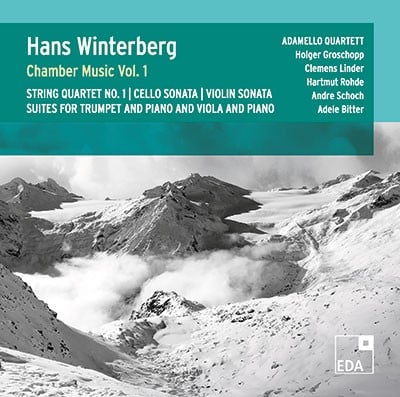Bote & Bock
There is an intriguing clipping that Hans Winterberg kept in a scrapbook of reviews, programmes, and occasional correspondence, which is held in the archive of the Exilarte Centre in Vienna. It neither records a date nor lists the names of the performers, but it does confirm that Winterberg’s Violin sonata was performed prior to his immigration to Germany in 1947. The font and general age of the paper suggests it was from the German language Prager Abendblatt. A similar clipping reviewing a Suite for Piano by Winterberg follows on the next page. This suggests the reviewer of the Violin sonata, who described it as using “all the performative techniques available”, while “offering a motific mosaic of sound effects”, was writing around 1937.
In his own work list, Winterberg gives the Violin Sonata 1935 as the date of its composition, while on the manuscript itself, he wrote “Prague, 18.XI 1936”. Unusually, he used the English spelling for Prague rather than the German “Prag” or Czech “Praha”. The two clippings are the only references in Winterberg’s scrapbook of his life prior to immigration. Subsequent research is now starting to offer a more complete picture of Winterberg as one of Czechoslovakia’s most promising young composers prior to the country falling to Hitler in March 1939.
The Sonata exhibits all the characteristics of Winterberg’s personal style: a sensuality of sound schooled in French Impressionism with simultaneous Expressionist strictness of harmony, motivic fragmentation, a sophisticated play with polyrhythmic patterns, and, especially in the last movements, an impetuous playfulness borrowed from Czech folklore. The first movement impresses with its unusual dramaturgy. In its course the melodic material is increasingly and obsessively dominated by a descending formula that evokes the German folk song “Schlaf, Kindlein schlaf”, which we will also encounter again in later works by Winterberg. The movement begins in full verve, only to gradually become more introspective and finally to pause in a melancholy state of suspension. The second movement contradicts the stereotype of the calm moment between two turbulent corner movements. It begins passacaglia-like, austere “like a conduct”, in grave ¾ time, and tends more towards defiant drama than lyrical songfulness. The last movement is unapologetic in offering a vigorous Slavic dance with a rondo-like return to the opening dance subject, offering a panoply of different ideas and moods until crashing abruptly without tonal resolution.
Michael Haas, September 2023

Clemens Linder, violin / Holger Groschopp, piano
eda records EDA 051
